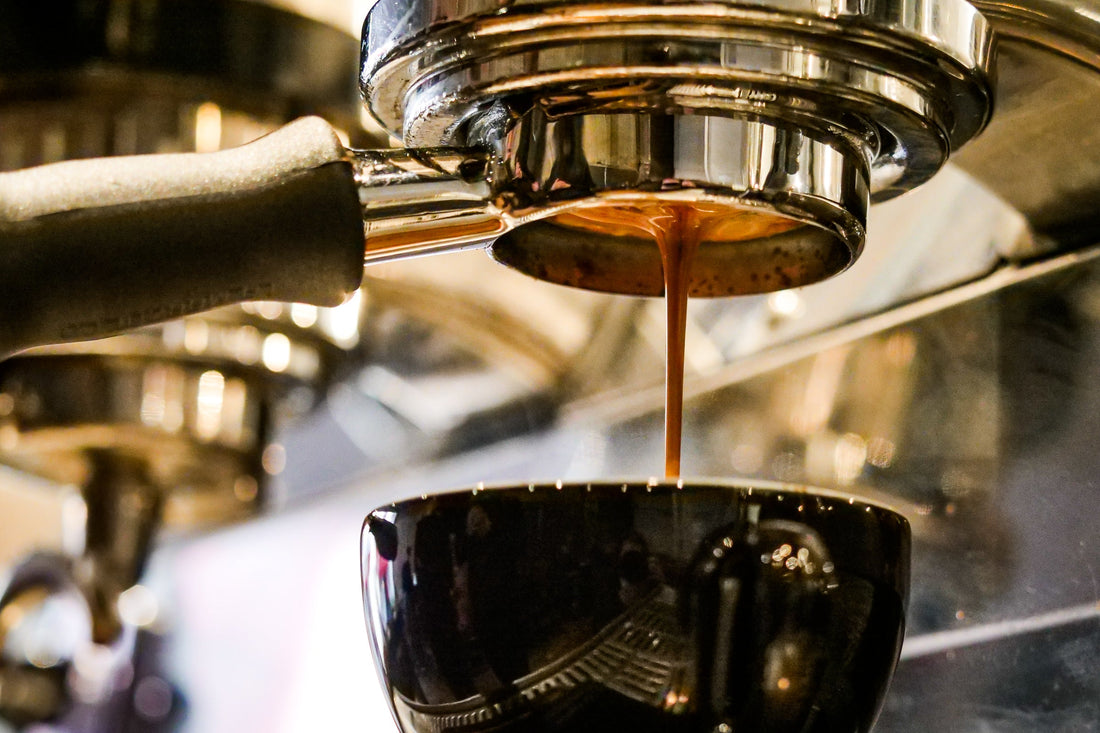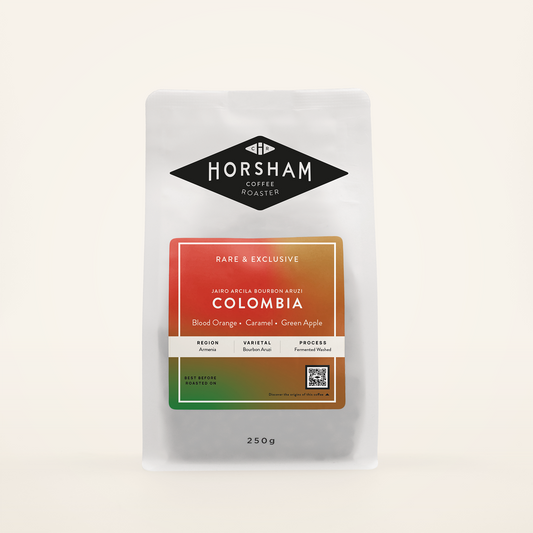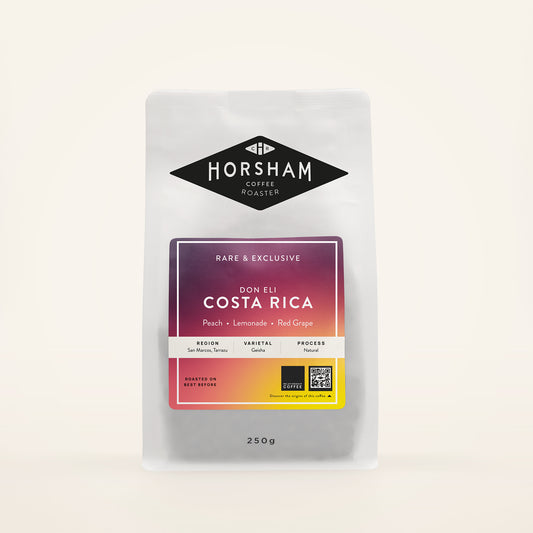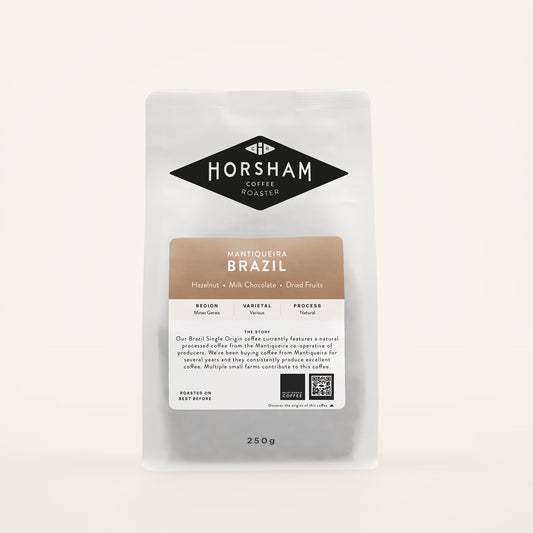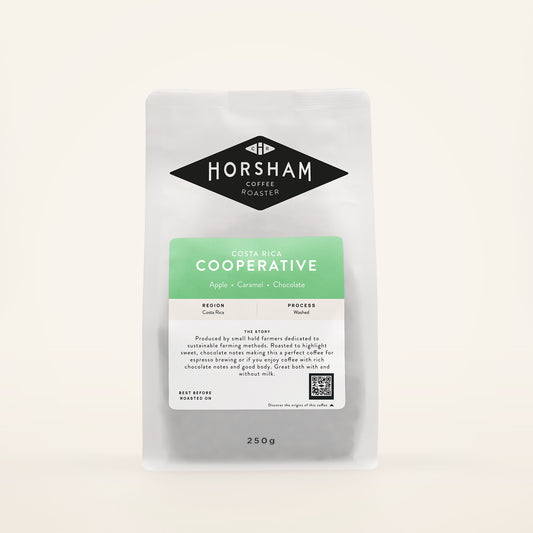Choosing the best coffee beans for espresso
Choosing the best coffee beans for espresso can sometimes be fairly challenging. Several factors might affect how someone would approach selecting the coffee they would want to use for espresso. Hopefully, this article will help you choose the right coffee from our website to suit your individual espresso coffee needs.
Equipment
Selecting the right equipment for espresso brewing can be tricky. There are so many options, and your budget might be the deciding factor. A good speciality coffee shop will usually have spent anything from £5000 to £25000 on their espresso-making equipment. This is far beyond the reach of most people brewing coffee at home but don't let that put you off! You can still make really great espresso coffee at home using fairly modest, more affordable equipment.
Brewing espresso at Bond St Coffee on a La Marzocco Strada ABR:

This level of equipment is generally designed to produce high volumes of espresso, so the grinders need to be able to grind several kilos of coffee per day, and the espresso machine will need to be able to cope with over 100 coffees per day. In order to do this, commercial coffee machines are made with industrial grade components and the very best machines will have more than one boiler for better temperature stability. Some commercial machines like the La Marzocco Strada can even feature advanced pressure profiling. The barista can vary the pressure to get the very best from the espresso coffee beans.
To make good espresso at home, you need to first invest in a suitable grinder that can grind fine enough to make espresso. Not all grinders can do this. As an example, the Wilfa Silver does not grind fine enough to be able to control espresso extraction. The Baratza Sette 270 is a fantastic home espresso grinder. We've got one at home, and it offers very precise grind adjustments. The great thing about these grinders is that justice can be done to best coffee beans in the world due to the even grind size and low heat generation of these grinders. While they aren't suited for commercial use they are perfect for anything up to 10 cups of coffee per day. If you are a heavy coffee drinker or prefer a more commercial-grade grinder, then the Ceado e6p is a great choice!
So how do you choose the best espresso coffee beans based on equipment? If you are using basic equipment at home (by this, we mean a total spend of less than £1000 on a grinder and espresso machine), we'd recommend sticking to one of our coffee blends. If you haven't tried our coffee, then we'd suggest starting with the espresso blend Nova:

The main reason for this is that the roast style is best suited for easy espresso extraction. By roasting slower and a bit darker than our single origin coffees, these beans will require less attention to detail and are very forgiving.
These are also a great starting point if you don't have a grinder and prefer to purchase pre-ground coffee.
So what should you choose if you have invested in excellent espresso equipment? If you have a grinder that can control the grind size and a good espresso machine (like the La Marzocco Linea Mini) your options are open, and we'd suggest exploring some of our other single-origin coffees. With care and attention to grind size, weighing of coffee dose and extraction, careful distribution and tamping, you should be able to get great espresso results from all of our single-origin coffee. Reducing pump pressure to 6 or 7 bar can also be a great way to minimise extraction problems with light roast single-origin coffees.
If you are looking for some tips on espresso brewing checkout our handy espresso brew guide and video.
Flavour characteristics of espresso beans
Choosing the best coffee beans for espresso is often determined by the type of espresso you enjoy. Espresso isn't a style of coffee but rather a method of brewing under high pressure. If you happen to prefer rich, bold, intense, heavy flavours from low acidity it's faily likely that you aren't going to enjoy a light roasted Kenyan coffee brewed for espresso!
The main reason for this is that some coffees from certain origins tend to showcase bright acidity. Typically the best coffees from Kenya, Colombia, Rwanda and Ethiopia will showcase a vibrant acidity that can often come across as quite sour when brewed as espresso. This can be avoided by making sure that you distribute the coffee very carefully in the portafilter and tamp correctly. This will help to reduce channelling when brewing the coffee, and you can keep an eye on this by using a bottomless portafilter. A perfectly extracted light roast single origin coffee can taste incredibly sweet with intense, juicy fruit flavours.
So, if your preference for espresso is something that showcases rich chocolate notes with low acidity and good sweetness and body we'd highly recommend our Nova blend. This blend contains 60% Brazil, a coffee that we have selected for a lower acidity showcasing chocolate, nutty notes. We blend this is 40% Rwanda, and this contributes a lovely sweetness and orange character. These are roasted darker than we would roast them as a single origin helping to tame the acidity and enhance body and chocolate notes.
If you like sweetness with a bit more acidity, our Workhorse blend is a great choice. Also made up of Brazil and Rwanda, this blend is roasted a bit lighter to allow a touch more acidity and fruit character.
What about single origin coffees? If you enjoy wild and fruity flavours in your espresso, then we'd highly recommend trying out some of our single origin coffees on espresso. Coffees that have been processed using the natural method tend to be very fruity with intense sweetness and vibrant acidity. Look out for our Costa Rican and Rwandan direct trade natural processed coffees.
Coffee with or without milk
The final thing to consider is how you intend to serve the coffee. If you are focusing on espresso or espresso with added water, then your options are open to trying out almost anything. The equipment, brewing technique and flavour preference will help you to choose your favourite espresso coffee.
If you are brewing coffee to be served with milk, you might find your options are a bit more limited. We find that the most suitable coffees to combine with milk are those with high sweetness and good body with chocolate notes. This helps the coffee to cut through the milk. Coffees with vibrant acidity can sometimes taste a bit sour when combined with milk. Natural processed coffees with intense fruit notes can sometimes taste incredible with milk. A great Ethiopian natural with strawberry notes can taste like strawberries with cream and chocolate when brewed as espresso and combined with milk!

The most important thing to remember is to experiment! Start with Nova or Workhorse and once you've perfected your espresso making skills you can branch out and give the single-origin coffees a go. Remember always to use filtered water when brewing as this can make a significant difference.
So should you use the best coffee beans you can get hold of to make espresso!? We say absolutly yes! Compromising on quality for espresso is the main reason so many home users, cafes and restaurants struggle to serve amazing espresso. By starting with outstanding coffee beans, you maximize your chances of brewing and serving great coffee. The one exception to this might be our Cup of Excellence and high priced limited-edition coffees. These are often priced too high to risk making espresso if the grind isn't quite right! It's much easier to make excellent filter coffee with these coffees.
